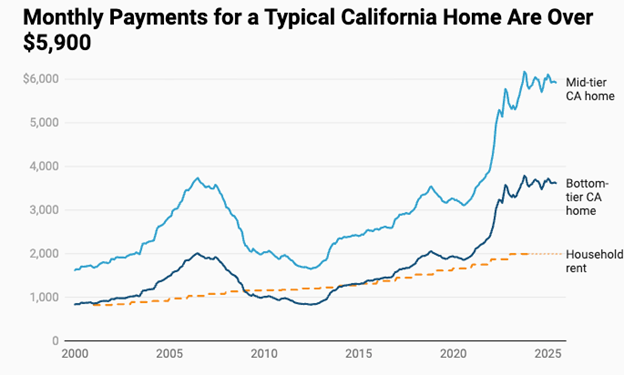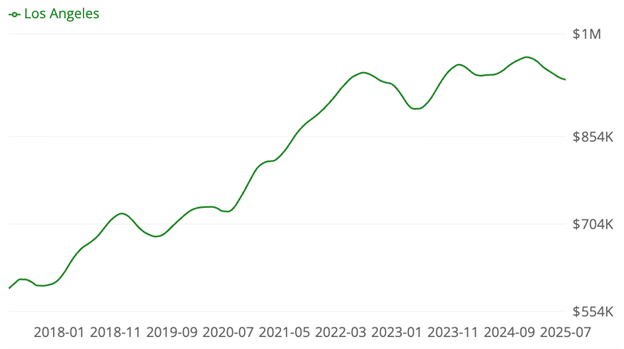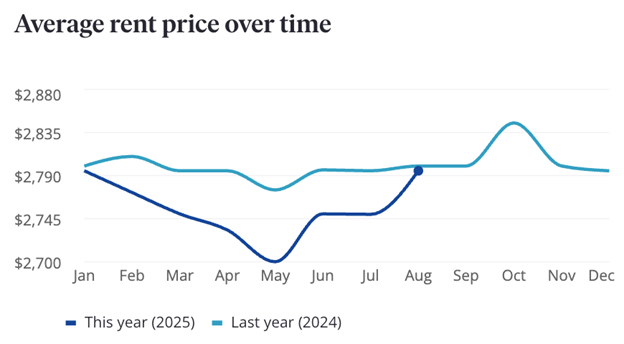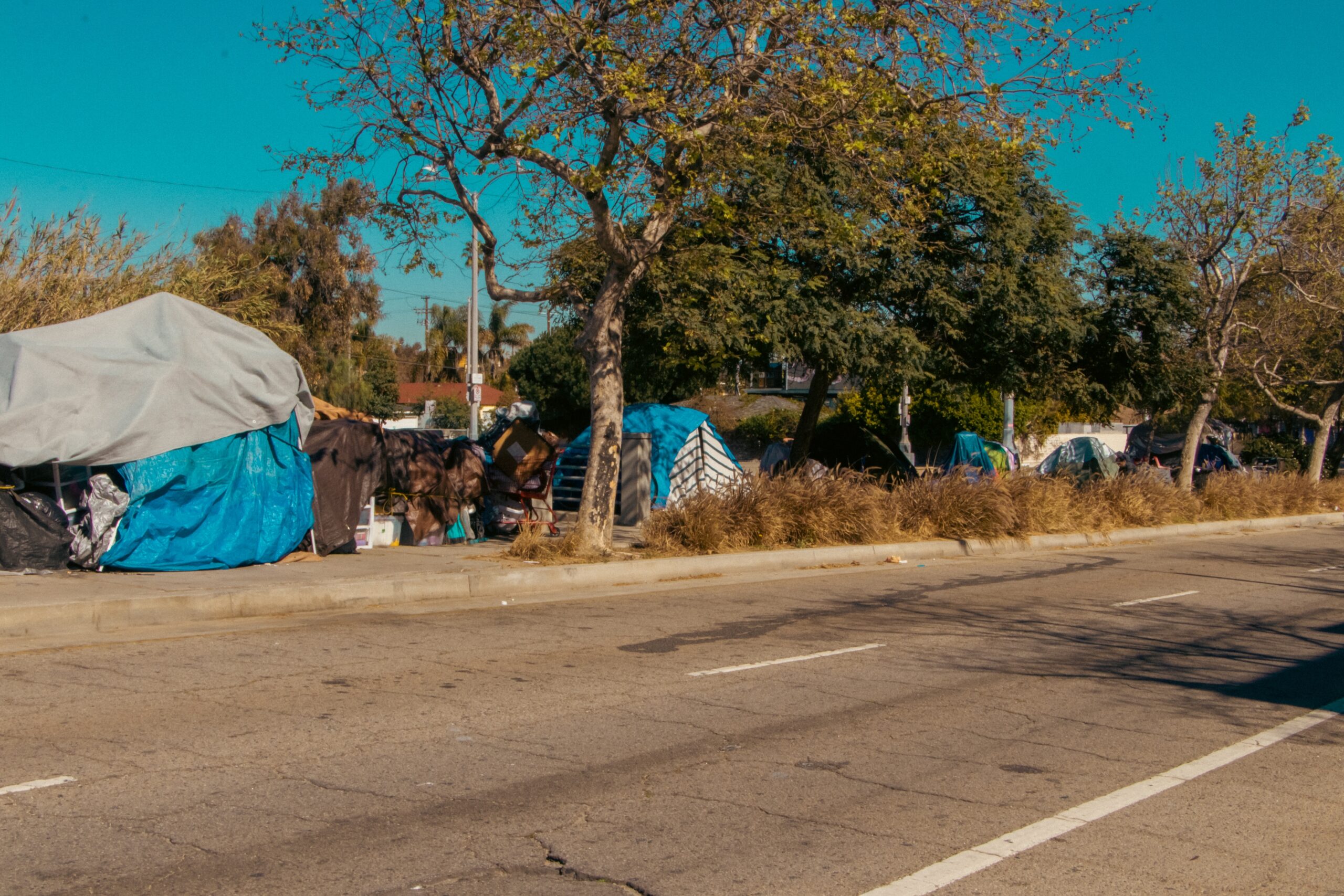According to the 2025 Greater Los Angeles Homeless Count from July, “For the second straight year, homelessness is down across Los Angeles County, falling 4% to 72,308. Homelessness also declined in the city of Los Angeles, falling by 3.4% to 43,699.”
That contrasts with a 3% increase in California in 2024 and 18% for the United States, according to data from the U.S. Department of Housing and Urban Development. Los Angeles must be doing something right besides winning the 2024 World Series.
There are many reasons for this change. For homelessness it’s best to start with homes—that is, housing costs. A July 24 study by the Legislative Analyst’s Office found, “California homes are about twice as expensive as the typical U.S. home,” costing $800,000. That’s also a quadrupling in price in the past 25 years. Monthly payments now are more than $5,900 for a mid-tier home, and $3,600 for one on the bottom tier.
However, since 2022 those numbers have stabilized for the first time since the subprime recession ended around 2012. Although all housing affects other housing, the homeless mainly are affected by rents, which have doubled since 2000. Those also have stabilized statewide, averaging around $2,000 a month. In the following LAO graph, note the yellow line for household rent.

I also checked Zillow for the city of Los Angeles. It showed a similar stabilizing of prices since 2022, but at a higher price than the state overall in July of $951,368.

For rents in Los Angeles, Zillow pegged the average for “all bedrooms” at $2,795. That’s about the same for the past two years. The chart even shows a dip this year, down from $2,795 in January to $2,700 in May, before jumping back up. That defied expectations the January wildfires would drive up overall rents. As the embers were smoldering, a January 19 San Francisco Chronicle article warned, “L.A. renters are some of the most cost-burdened in the U.S. The fires could make things worse.” But that didn’t happen. The Zillow rent graph shows 2025’s temporary dip in dark blue:

The population of Los Angeles also has declined 0.5% since the 2020 U.S. Census, also the year of the COVID-19 pandemic, from 3,898,747 to 3,878,704 in 2024. In 2025, the number could drop further.
Local efforts to reduce the number of homeless have been effective. “Homelessness has gone down two years in a row because we chose to act with urgency and reject the broken status quo of leaving people on the street until housing was built,” said L.A. Mayor Karen Bass, as quoted in the LAHSA report. Aside from the political rhetoric, here are some specific actions that may have helped.
In 2017, 69% of Los Angeles County voters passed Measure H, which funded homeless programs with a 0.25% sales tax. Specific accomplishments included:
- The homeless response system has placed 119,433 people into permanent housing since 2017—and 36.9% (44,129) were housed with Measure H funding.
- The homeless response system has placed 157,141 into interim housing since 2017—52.8% (82,966) housed with Measure H funding.
Last November, county voters passed Measure A, a 0.5% sales that doubled Measure H’s tax, and replaced it. It went into effect on April 1, so it’s too early to assess its effects. But a post-election Fact Sheet by the County of Los Angeles Homeless Initiative promised:
Generating over $1 billion annually, Measure A funding will be shared by LA County, cities and councils of government, the Los Angeles County Development Authority (LACDA), and the Los Angeles County Affordable Housing Solutions Agency (LACAHSA), a body made up of leaders including the LA County Supervisors, elected officials representing cities countywide, as well as nonprofit and community leaders.
At the state level, in March 2024 voters barely passed Proposition 1, the Behavioral Health Services Program and Bond Measure, 50.18% to 49.82%. It will issue $6.8 billion in bonds. The Legislative Analyst described its two components:
- Changes the Mental Health Services Act that was passed by voters in 2004, with a focus on how the money from the act can be used.
- Approves a $6.4 billion bond to build (1) more places for mental health care and drug or alcohol treatment and (2) more housing for people with mental health, drug or alcohol challenges.
Although there was no tax increase, the cost is $310 million a year from the general fund, which must be paid either by a tax increase or cutting other spending. It’s also too early to see how this is working.
More spending for housing will have a positive effect, despite the usual government waste, such as paying higher wages for Project Labor Agreements. But increased taxes will take a toll on the overall economy, stifling jobs and businesses, and pushing people out of the city and the state. Ironically, those who leave, by reducing demand, will contribute to lower housing prices.
Undoubtedly positive actions for housing include numerous pro-housing bills. Nixon Peabody listed 32 such bills signed last year alone by Gov. Gavin Newsom. And on June 30 this year, his office boasted of a long-desired reform of environmental laws: “CEQA Reforms to accelerate housing and infrastructure by streamlining CEQA review to speed up delivery of housing and infrastructure projects—including infill housing, high-speed rail facilities, utilities, broadband, community-serving facilities, wildfire prevention and farmworker housing.”
The U.S. Supreme Court’s Grants Pass v. Johnson decision last year also made it easier for Los Angeles and other cities to clear away homeless encampments from public parks.
In sum, Los Angeles’ reduction in homelessness likely will continue from the momentum of all these reforms. Just in time for the World Cup and the Olympics. Let the games begin.
John Seiler is on the Editorial Board of the Southern California News Group.

